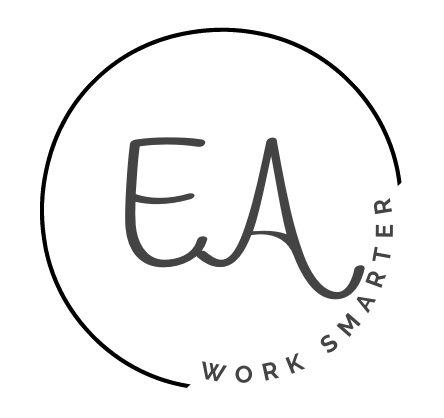
Elementary Assessments

51 Narrative Writing Prompts for 3rd Grade: Great Ideas
Here you will find an assortment of narrative writing prompts for 3rd grade.
Not only do these third grade narrative writing prompts reduce writer’s block, they encourage students to apply new skills and reflect upon personal experiences.
Writer’s workshop just became a bit more exciting.
So include in your lessons this week a handful of these delightful narrative writing prompts for 3rd grade.
Narrative Writing Prompts for 3rd Grade
Even reluctant writers enjoy responding to these fun narrative writing prompts for 3rd grade.
1. Write about your first time visiting another state or country. How was the location different and similar to where you live?
2. Tell a story about a time when you helped someone in need.
3. Write a story about the best activity at field day last year. What made this activity so great? Describe it.
4. Describe a memory about a fun Easter egg hunt in which you participated.
5. Tell the story about a strange thing that has ever happened to you.
6. Tell your favorite things to do at the beach.
7. Write about a time when you had to apologize to someone.
8. Describe the person who has the most influence over your life. Explain why this person is so important in your life.
9. Tell about your favorite holiday memory.
10. Write about the most memorable field trip that you have ever taken.
11. Of all the things you own, which is the one you value most and why?
12. Share three to five S.M.A.R.T goals that you have for this school year. Then tell how you will accomplish them.
13. Write about a time when you lost a game.
14. Write about a fun fall activity that you did with your family.
15. Share information about a time when your parents surprised you with a special gift.
16. Write about a challenge that you have faced or are facing this school year. What steps are you taking to overcome this obstacle?
17. Describe the most joyous Thanksgiving celebration you’ve ever attended.
18. Suppose you invented a time machine. Write a story about the adventures you’d have with it.
19. What is breakfast time like in your house?
20. If you were teacher for the day, what fun activities would you do with the class?

21. Draft a story about yourself as the hero.
22. Retell a memory about doing a science experiment.
23. Write about the best birthday celebration you’ve every had.
24. If you could drive for one day, where would you go, with whom, and what would you do?
25. Tell about a reward you received.
26. If you could travel to the future or the past, which year would you travel to and why?
27. Share a scary moment that happened to you.
28. What is your favorite season of the year? What do you like to do during this time?
29. Tell about a time that you had a strange, funny, or scary encounter with an animal.
30. Tell your strategy for responding well to narrative writing prompts for 3rd grade.
31. Describe a time you stood up for yourself.
32. When has something been very hard for you but you kept trying?
33. Describe the most exciting vacation you ever took.
34. Tell about a memorable Christmas morning.
35. Share a bad hair day experience.
36. What are some things that you wish your teacher knew about you.
37. Summarize dinner time with your family.
38. Write about a fun field trip memory.
39. What’s your favorite memory from last school year?
40. Tell about a memorable Field Day event.
41. Write about a school event that was special to you.
42. Share a memory of when you were surprised with a new pet.
43. Tell about a time when you felt proud.
44. Describe your experience learning to ride a bike.
45. Share a funny memory with your family.
46. Share a timeline of your life.
47. Write about a time when you did a fun arts project.
48. If you had three wishes, what would you wish and why?
49. Write about a time when you gave a class presentation.
50. How do you spend snow days off from school?
51. Write about your experience being a new student.
Final Thoughts: Narrative Writing Prompts for 3rd Grade
Now you have a quality collection of third grade narrative writing prompts to use for various writing activities.
Related: books that help teach narrative writing
- Grades 6-12
- School Leaders
Get Our New Humor/Advice Newsletter to Your Inbox Every Monday!
15 Inspiring Personal Narrative Examples for Writers
Reveal a part of yourself in your essay.
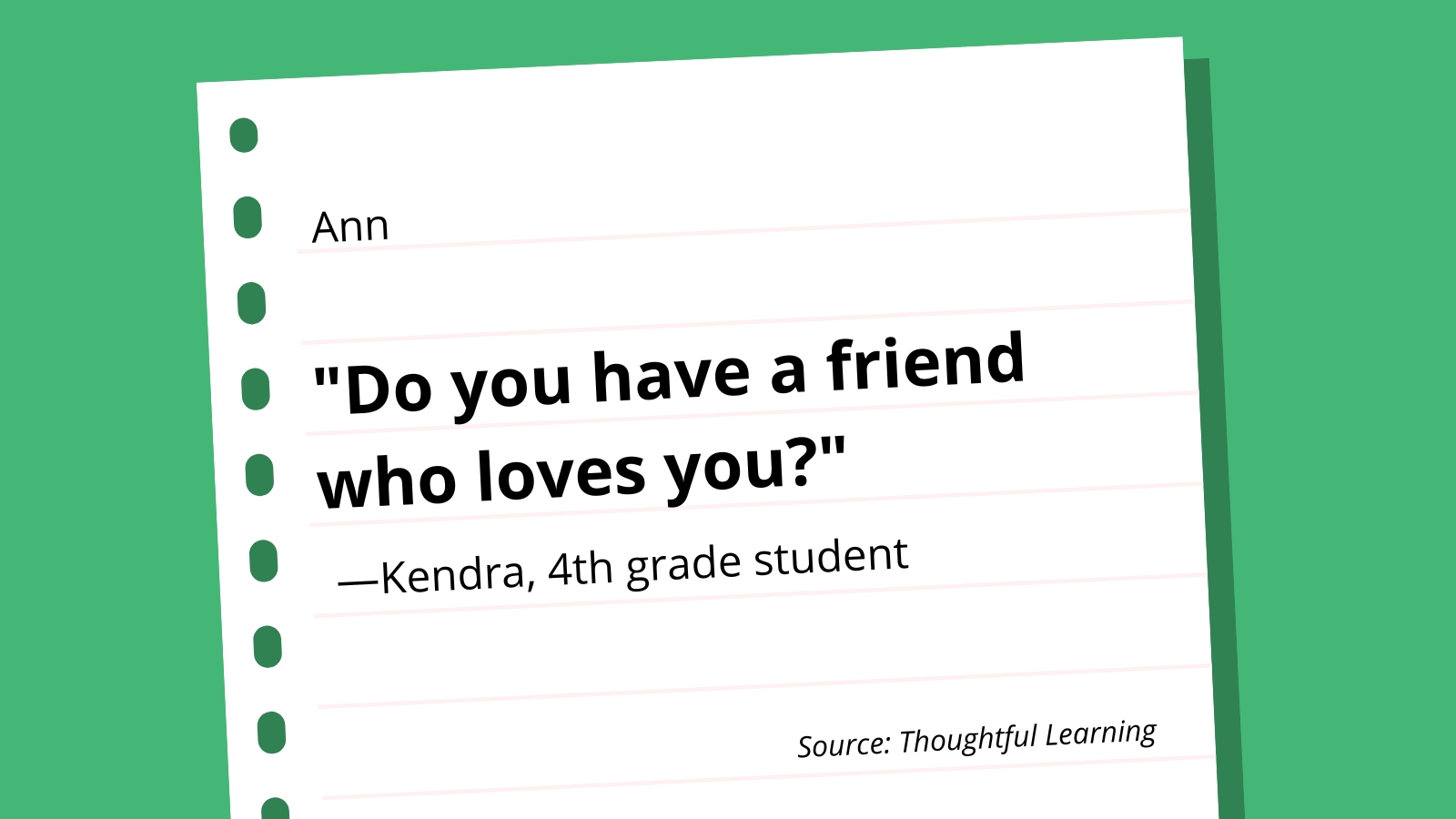
Students start writing personal narratives at a young age, learning to use descriptive language to tell a story about their own experiences. Try sharing these personal narrative examples for elementary, middle, and high school to help them understand this essay form.
What is a personal narrative?
Think of a narrative essay like telling a story. Use descriptive language, and be sure you have a beginning, middle, and end. The essay should recount your personal experiences, including your thoughts, feelings, and actions.
Learn more about personal narrative essays here:
What Is Narrative Writing, and How Do I Teach It in the Classroom?
- Engaging Personal Narrative Ideas for Kids and Teens
- Best Mentor Texts for Narrative Writing in Elementary School
Elementary School Personal Narrative Examples
In elementary school, personal narratives might be quite short, just a paragraph or two. The key is to encourage kids to embrace a personal style of writing, one that speaks in their own voice. Take a look at these elementary school personal narrative essay examples for inspiration.
The Horrible Day
“next i fell asleep in my cereal and my brother stole my toast”—anonymous student.
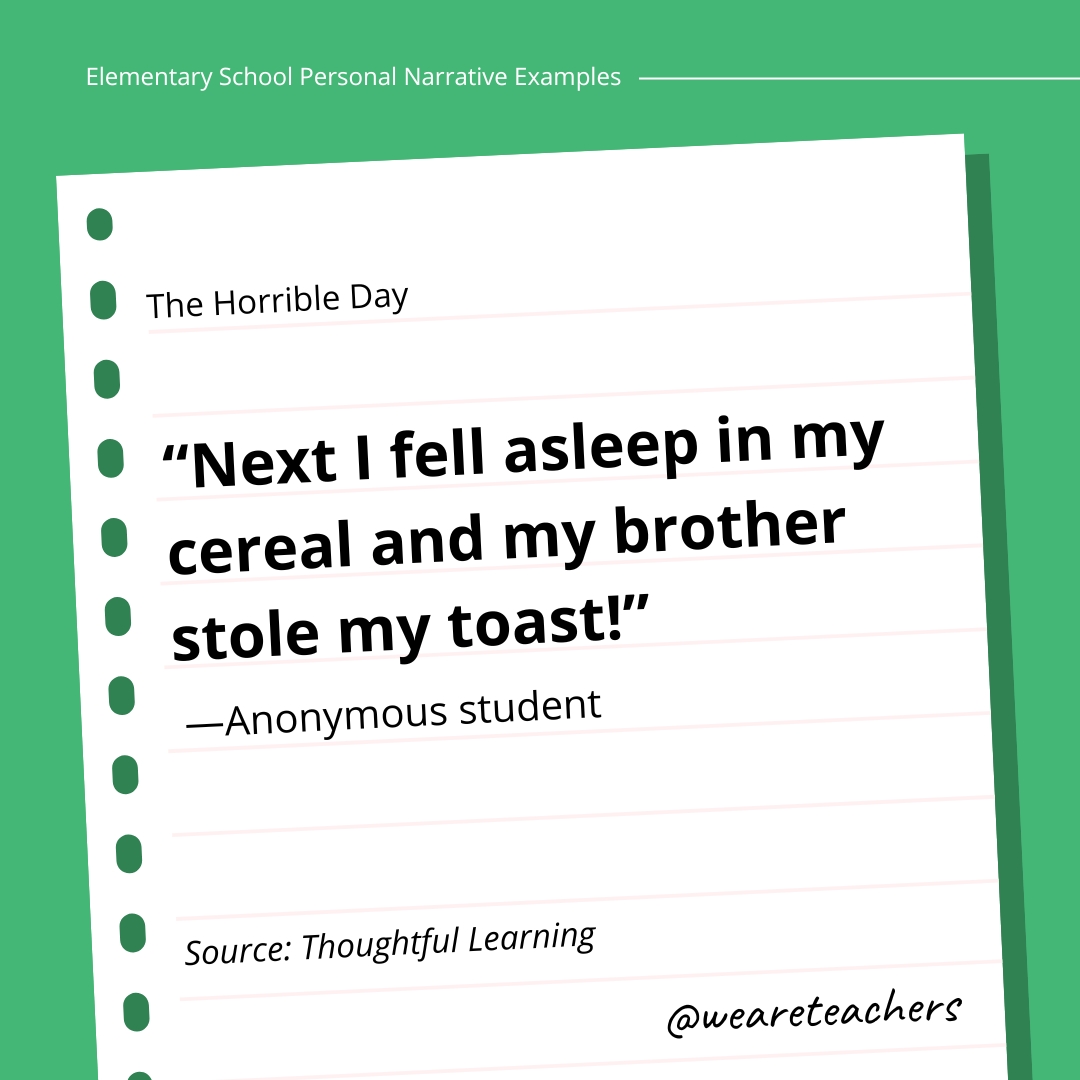
In this short personal narrative written by a 2nd grader, the author describes a bad day with lots of details and an informal tone. It’s a great model for your youngest writers.
Read the full essay: The Horrible Day at Thoughtful Learning
Keep an Eye on the Sky!
“as we made our way out to the field, my stomach slowly turned into a giant knot of fear.” —anonymous student.
Any student who dreads gym class will connect with this essay, which turns a challenge into a triumph. This narrative from Time for Kids is annotated, with highlighted details and tips to help kids write their own essay.
Read the full essay: Keep an Eye on the Sky! at Time for Kids
Grandpa, Chaz, and Me
“i really miss grandpa, and so does my brother, even though he never met him.” —cody, 4th grade student.
Written by a 4th grader, this essay relates the author’s loss of a grandfather at a very young age. Using simple, personal language, they tell a compelling story in a few short paragraphs.
Read the full essay: Grandpa, Chaz, and Me at Thoughtful Learning ADVERTISEMENT
Surviving an Embarrassing Situation
“i had made the shot in the wrong basket, giving the green shirts the win” —anonymous student.
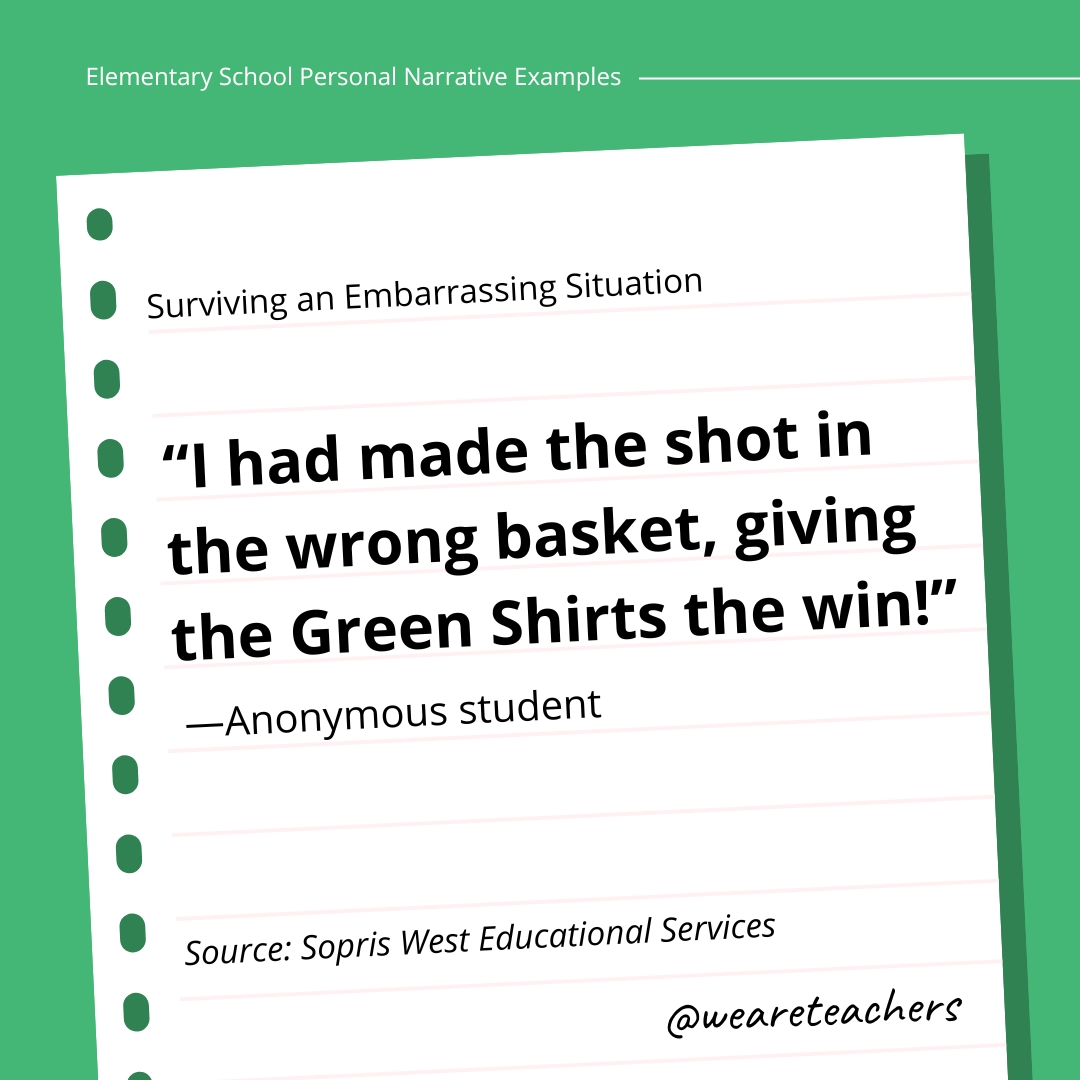
Personal narratives tell a story, with a beginning, middle, and end. This annotated essay outlines those parts, making it easier for young writers to do the same in their own writing.
Read the full essay: Surviving an Embarrassing Situation at Sopris West Educational Services
“Do you have a friend who loves you?” —Kendra, 4th grade student
Writing about friends gives writers the chance to describe someone’s physical characteristics and personality. This 4th grade essay uses personal details to bring a beloved friend to life.
Read the full essay: Ann at Thoughtful Learning
Middle School Personal Narrative Examples
By middle school, personal narratives are longer and more involved, telling more detailed stories and experiences. These middle school personal narrative essay examples model strong writing skills for this age group.
“As thoughts of certain death run through my mind, the world appears a precious, treasured place.” —Amy, student
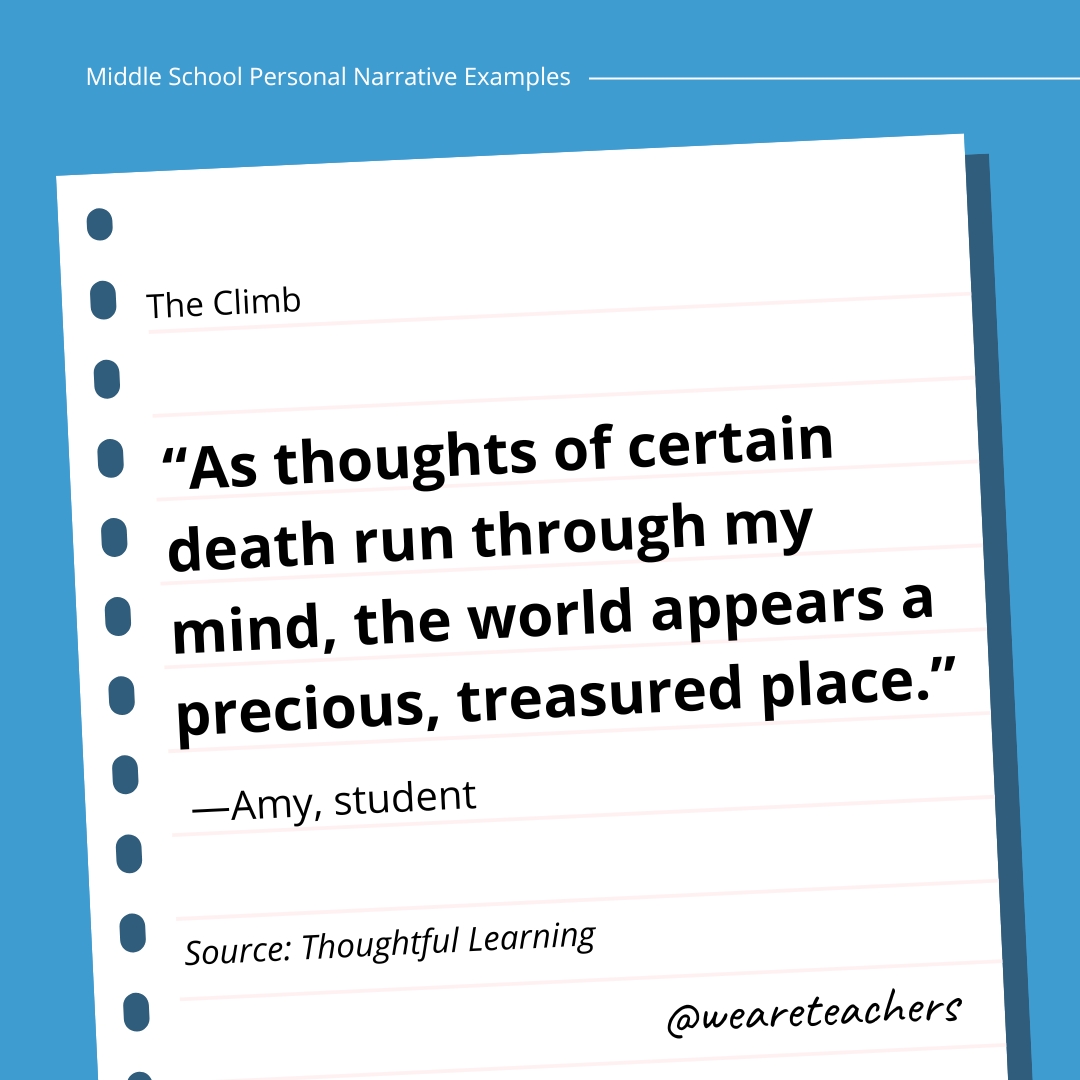
Describing an opportunity to overcome your worst fears makes an excellent personal narrative topic. The vivid descriptions of the landscape and the author’s feelings help the reader make a strong connection to the author.
Read the full essay: The Climb at Thoughtful Learning
The Best Friend Question
“i’ve often wondered, does not having a best friend make me defective” —blanche li, age 13, diablo vista middle school, danville, california.
When her Spanish teacher asked students for an essay describing their best friend, 13-year-old Blanche Li fell back on her standard story: that of a made-up person. Here, she explains why she made up “Haley” and wonders what having an imaginary best friend says about her.
Read the full essay: The Best Friend Question at The New York Times
The Racist Warehouse
“i didn’t know racism was still around; i thought that situation had died along with dr. king.” —alicia, 8th grade student.
Strong personal narratives often relate the way the author learned an important life lesson. Here, an 8th grader describes her first experience with racism, in an essay that will sadly ring true with many readers.
Read the full essay: The Racist Warehouse at Thoughtful Teaching
“For the first time, we realized that we didn’t know how to express our voice, and we always suppressed it.” —Jocelyn C., 7th grade student, Texas
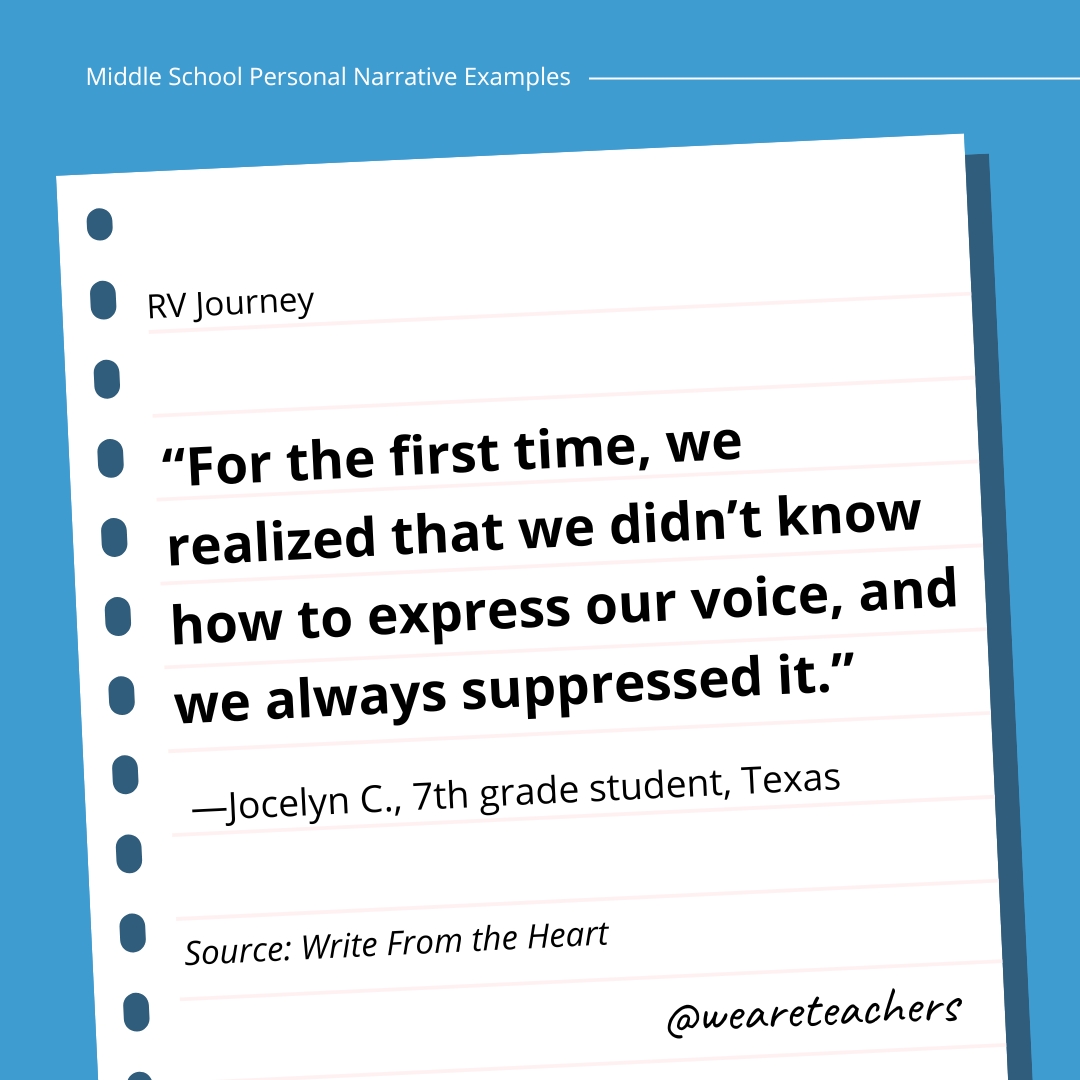
Seventh-grader Jocelyn C. describes the unique experience of spending two years living in an RV with her family, traveling the country. She relates the ups and downs of their trip, illustrating the way her family learned to live together in close quarters and embrace the adventure.
Read the full essay: RV Journey at Write From the Heart
An Eight Pound Rival
“i’m trying to accept that he didn’t mean to dominate the center stage all the time, that’s just one of the many lovable assets of his personality.”.
A new sibling can change everything in a family, especially when you’ve always been the baby. This middle schooler explains her challenging relationship with a little brother that she loves, even when he drives her a bit crazy. (Find this essay on page 42 at the link.)
Read the full essay: An Eight Pound Rival at Teaching That Makes Sense
High School Personal Narrative Examples
High school students have more complex stories to tell, though they’re sometimes reluctant to do so. Reading personal narrative essay examples like these can encourage them to open up and get their thoughts, feelings, and ideas down on the page.
Sorry, Wrong Number
“when i received the first text, i was a playful sixth grader, always finding sly ways to be subversive in school and with friends.” —michelle ahn, high school student.
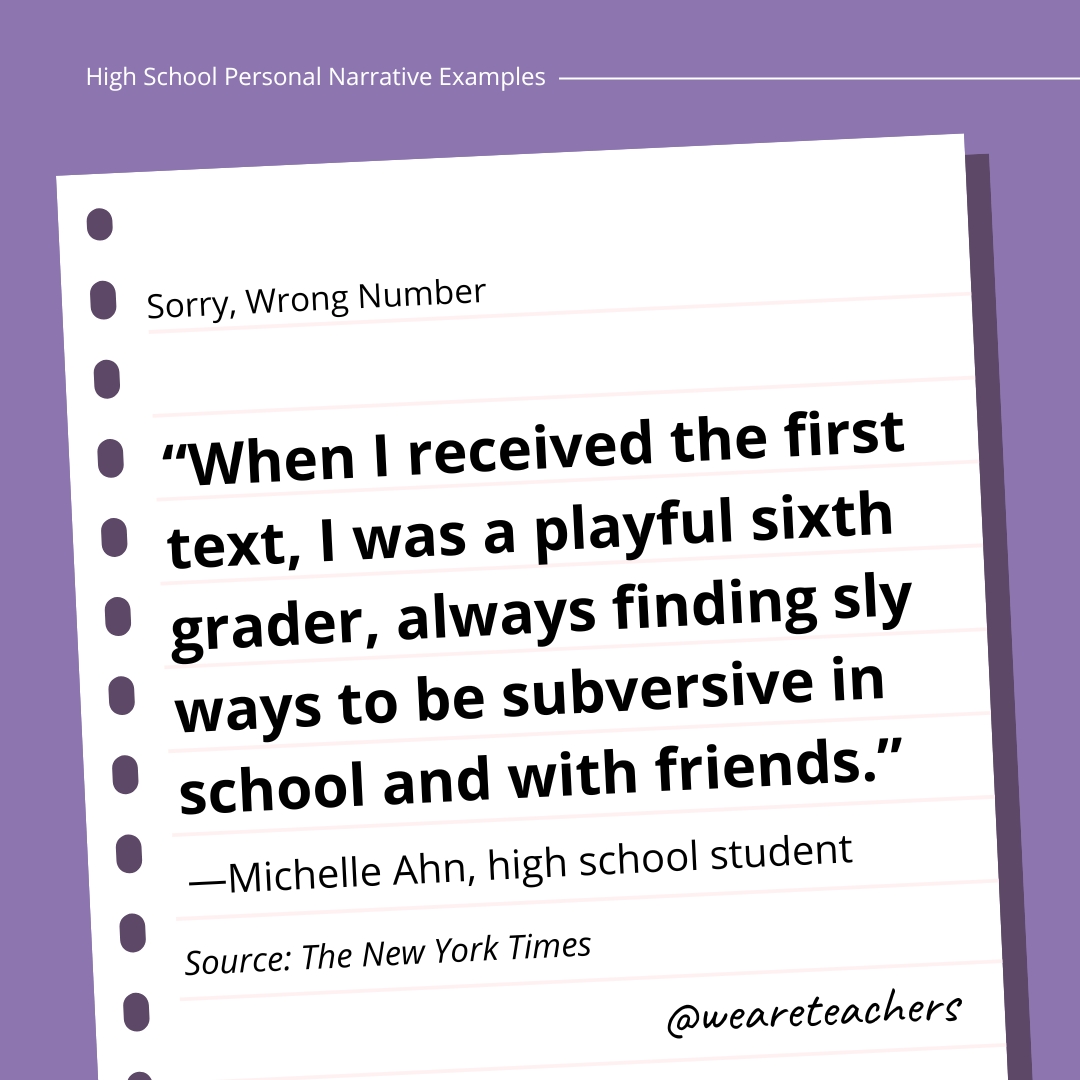
When Michelle Ahn was 11, she started getting texts for a wrong number, a man named Jared. Rather than correcting the error, she spends the next few years occasionally engaging with his texters as “Jared,” learning more about him. Though she finally comes clean, her time as “Jared” exposes her to a way of life very different from her own, and opens her eyes to the inner lives of others.
Read the full essay: Sorry, Wrong Number at The New York Times
Caught in the Net
“little does everyone else know how often i’m not doing school research or paper writing; instead i’m aimlessly writing emails or chatting with internet friends and family hundreds of miles away.” —kim, college student.
Even before social media and smartphones swept the world, internet addiction had become a problem. Here, a student shares her experiences in AOL chat rooms, meeting people from around the globe. Eventually, she realizes she’s sacrificing life in the real world for her digital friends and experiences, and works to find the right balance.
Read the full essay: Caught in the Net at Thoughtful Learning
Nothing Extraordinary
“an uneasy feeling started to settle in my chest. i tried to push it out, but once it took root it refused to be yanked up and tossed away.” —jeniffer kim, high school student.
During an ordinary shopping trip, high schooler Jenniffer Kim suddenly realizes she’s ashamed of her mother. At the same time, she recognizes all the sacrifices her mom has made for her, and gladly takes the chance to make a tiny sacrifice of her own.
Read the full essay: Nothing Extraordinary at The New York Times
The Pot Calling the Kettle Black
“at this point in life, i had not yet learned to be gentle with myself, or others.” —anonymous student.
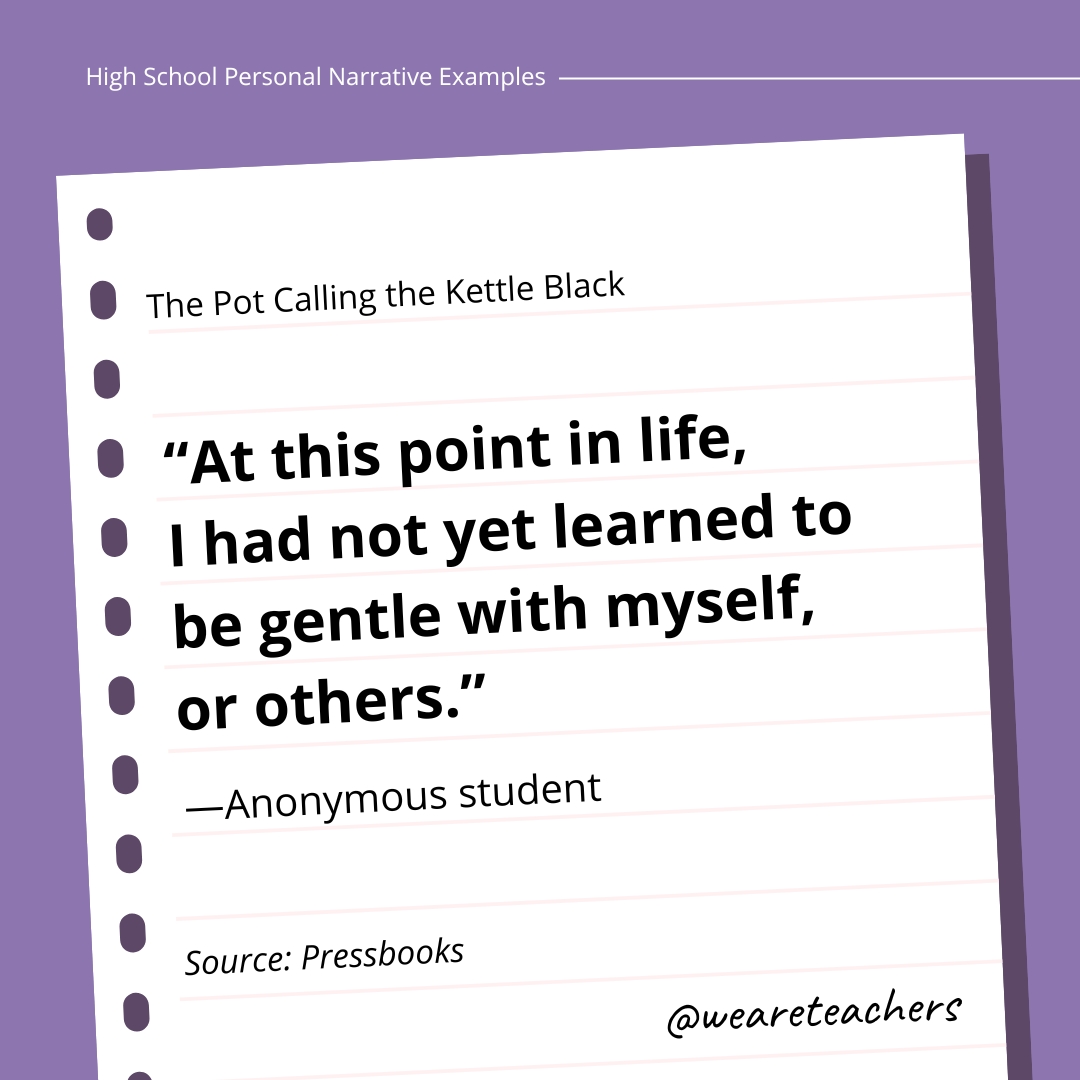
A teen who lives with bipolar disorder recounts a difficult conversation with her parents, in which her mother dismisses her as “crazy.” A few years later, this same teen finds herself in the emergency room, where her mother has just tried to die by suicide. “Crazy!” the daughter thinks. After her mother also receives a bipolar disorder diagnosis, the author concludes, “‘Crazy’ is a term devised to dismiss people.”
Read the full essay: The Pot Calling the Kettle Black at Pressbooks
What a Black Woman Wishes Her Adoptive White Parents Knew
“i know that i am different, but do not have the words to understand how.” —mariama lockington.
Though not written by a high schooler, this essay by Mariama Lockington makes an excellent mentor text for this age group. Lockington dives deep into her feelings about being adopted by parents of a different race, and shares her challenges in poignant language that speaks directly to the reader.
Read the full essay: What a Black Woman Wishes Her Adoptive White Parents Knew at Buzzfeed News
Do you use personal narrative examples as mentor texts in your classroom? Come share your experiences and ask for advice in the We Are Teachers HELPLINE group on Facebook !
Plus, strong persuasive writing examples (essays, speeches, ads, and more) ..
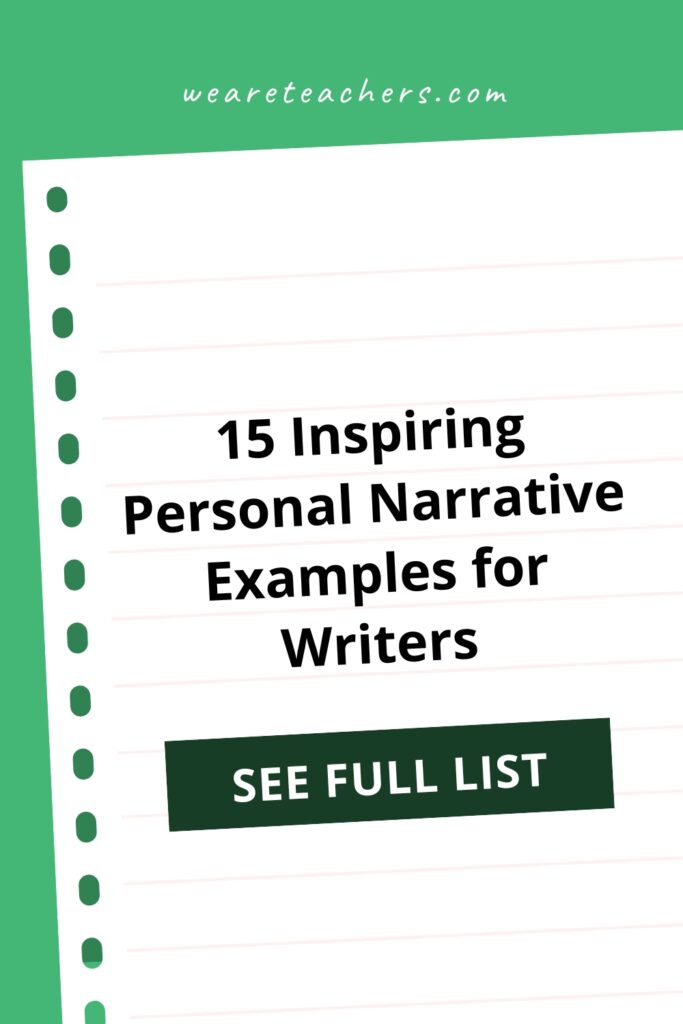
You Might Also Like
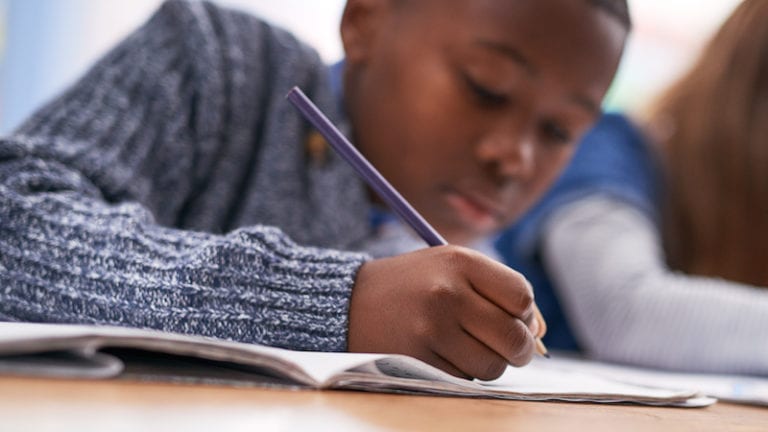
It's more than just telling stories. Continue Reading
Copyright © 2024. All rights reserved. 5335 Gate Parkway, Jacksonville, FL 32256

5 Hooks to Teach Your Students for Writing a Strong Introduction
When teaching my students how to write a personal narrative , I always teach them to start by writing a strong introduction, also known as an opening hook.
This can be anything from starting in the middle of the action, to asking a question, to giving a surprising fact.
The important thing is that it will make the reader want to keep reading to find out more!
Read on to learn about each of the five hooks. 👉 Be sure to read until the end of the post 👈 because I’m also sharing a fun way to practice them with your class! (Plus, how you can get 100 EXCITING narrative prompts for FREE!)
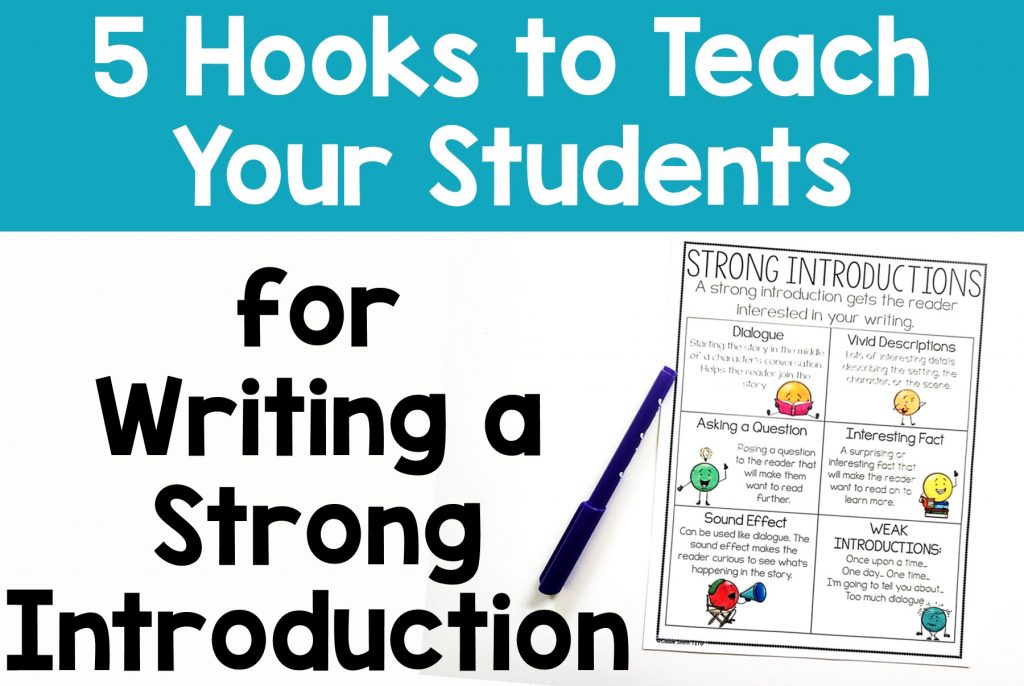

Here Are 5 Of My Favorite Hooks for Writing a Strong Introduction to Narratives ✏️
1. jump right into the action.
Start with an exciting event that will make the reader want to read on.
No one wants to read about the main character waking up and brushing their teeth. Start with something exciting, like the character being chased by a pack of wild dogs or winning the big game.
2. Use vivid descriptions.
When setting the scene or introducing the characters, use lots of detail.
What does the character look like? What are they wearing? What’s the temperature outside?
Teach your students that the more specific they can be, the better. Using sensory language (sight, sound, smell, taste, and touch) really bring the scene to life for the reader.
Remind them that they want their reader to feel like they are right there in the story with the character!

3. Ask a question.
Posing a question at the beginning of the story will make the reader curious and want to find out the answer.
Asking a question is a great way to get readers thinking about what’s to come. Will the character be able to outrun the dogs? Will they win the game?
By posing a question, they’ll keep their readers guessing and engaged.
4. Share an interesting fact.
Give a surprising fact related to the story that will make the reader want to keep reading to learn more.
This could be something about the character or the setting. Whatever it is, make sure it is something that will pique their curiosity.
5. Use sound effects.
Just like dialogue, using a sound effect can be a great way to start the story.
Sound effects are a great way to set the tone for the story and add an extra layer of excitement for readers.
Imagine hearing the sound of barking dogs as you’re reading about someone being chased! This could be something as simple as a door slamming shut or glass breaking.
The important thing is that it draws the reader into the story and makes them want to know what happens next!

By using one of these opening hooks, you can teach your students to pull the reader into their story and set the stage for an exciting adventure.
It’s always a good idea to use a mentor text, or personal narrative example when you are modeling this with your students.
READ MORE>>> Using Personal Narrative Examples While Teaching Writing
Now Practice Writing a Strong Introduction With Your Class and Make It Fun!✏️
These are just a few of the ways that you can teach your students to start their personal narrative with a bang!
After you read a story aloud with your class, model rewriting the introduction to the story.
This can be a fun activity to get your whole class involved in. Use the five different types of hooks mentioned above to write the new introductions.

✏️Here’s an example of rewriting an intro to Jack and the Beanstalk. Can you name each type of hook?
1. “Magic beans? What are magic beans?”
2. The thick, green beanstalk stretched as high as I could see. I looked up, shielding my eyes from the bright sun and watched the beanstalk wind its way into the clouds.
3. “MOOOOOO!”
4. Did you know cows never sold for less than 100 coins? When I came home with five magic beans, my mom was not happy with me.
Here are the answers: 1. Start with a question. 2. Use vivid descriptions. 3. Sound Effect 4. Question/Interesting Fact
You can get help teaching your students to write personal narratives with our Grades 2-5 Personal Narrative Writing Units !

Looking for EXCITING narrative writing prompts? Get a list of 100 that your students will LOVE! 👇
Learn 6 tips for teaching your students to write a personal narrative. 👇.
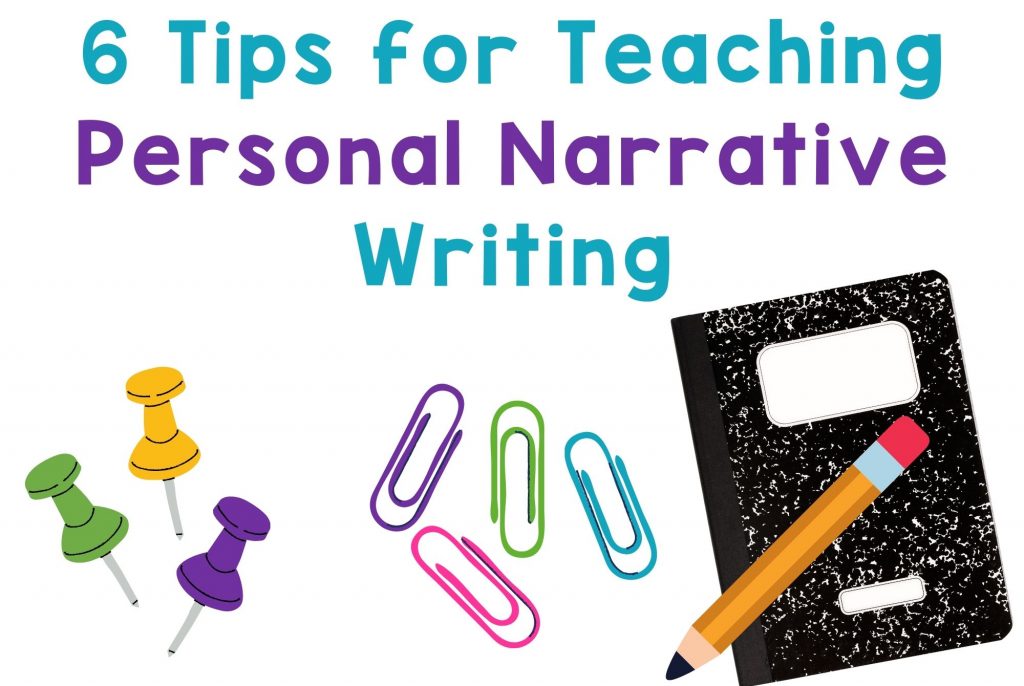
You might also like...

Using Personal Narrative Examples While Teaching Writing in 3rd, 4th, and 5th Grades

How to Teach Informational Writing: Lessons & Activities (25 Topic Ideas)

Teaching Personal Narrative Writing at the Beginning of the Year
What teachers are saying, find what you need.

Let's Connect
Join my email list.
Get teaching ideas, lesson tips, and freebies sent right to your inbox!
- Skip to primary navigation
- Skip to main content
- Skip to primary sidebar
- Skip to footer
Raise the Bar Reading
A Reading Teacher's Blog
Teaching Narrative Writing in 1st, 2nd, and 3rd Grade
When teaching narrative writing in 1st, 2nd, and 3rd grade, there are so many writing skills to cover. They range from creating a sequence of events (beginning, middle, and end) to more difficult skills like building strong characterization. With a class full of students at such varying levels of writing, it can be overwhelming to think of where to start with your narrative writing unit.

Narrative writing can be one of the most motivational types of writing for students since the topics can be something they feel connected to in their own lives. Personal narratives allow them to talk about their own experiences they want to share, and fictional narratives let students create a story about absolutely anything that they want!
As you can see in the chart below, students are expected to do a little bit more with narrative writing as they grow as writers from 1 st to 3 rd grade.

So, 1 st grade focuses on developing sequenced events (beginning, middle, end). With 2 nd and 3 rd grade, the focus is creating a hook/opening, events (beginning, middle, end), and a closing. In 2 nd and 3 rd grade students also need to begin to develop characterization.
For young writers learning such a new, specific format of writing, it is really important to break it up into small, clear steps.
Below is how I tackle narrative writing step by step:
INTRODUCE NARRATIVE WRITING:
First, I explain what a narrative is with visuals and examples. I go through a pre-written narrative writing example. These examples will differ depending on whether we are working on writing fictional narratives or personal narratives.

We identify and discuss each part of the piece of writing. For first graders that means the beginning, middle, and end. For second and third graders, that means an opening, events (beginning, middle and end), and closing.
GUIDED WHOLE GROUP PRACTICE:

I like to model the actual process of writing a narrative as well. With modeling a personal narrative, I like to pick an experience we have had in school that year so that it is easy for students to participate. I keep this model basic and clear so that students are not overwhelmed in what they need to produce in their first piece of narrative writing. While modeling, I refer to the prewritten example that I provided earlier. I also display sentence starters and transitions to use as a guide.
INDEPENDENT NARRATIVE WRITING PRACTICE:
First, students can practice the narrative format by using picture prompts for beginning, middle, and end. They use the visuals to describe what happens from the beginning to the end of their story.

Next, it’s time for students to begin fictional narrative or personal narrative writing from scratch! At first, I usually provide a writing prompt for the entire class that is easily relatable. The prompts will vary depending on if we are working on writing personal narratives (“Tell about a time when…”) or fictional narratives (“Write a story about…”). However, you could also give multiple options or have students develop their own individual topics.
During the prewriting phase of the writing process, students brainstorm using graphic organizers.

I like give students two graphic organizers – one for them to first brainstorm ideas for their drafts, and then one to organize their ideas into a narrative writing format.

While writing their drafts, students can refer to sentence starters to help guide them in writing their stories.
After writing their drafts, I give students an editing checklist to use as a reference. This makes it easier for them to make sure they have included each part of a piece of narrative writing.

TARGET NARRATIVE WRITING SKILLS:
As students are ready, I target specific narrative writing skills either as a whole class, or with just a small group that is ready for taking their writing to the next level.
To introduce a particular narrative writing skill (i.e. writing narrative hooks), I display a poster that is student-friendly with visuals and examples. Then, I have graphic organizers or practice pages that students can use to work through each strategy on their own.
Most students will need help with the following narrative skills:
Writing a Strong Narrative Hook:
Breaking narrative hooks down by hook types is so helpful for giving them some tools for creating their own leads. Grab the posters below and a couple practice writing pages for free here .

Writing a Strong Narrative Ending:
Similar to writing hooks, breaking down narrative endings by type is also a helpful way for students to try out different closings for their piece of writing.

Small Moments Writing:
So often, personal narratives can just turn into a list of moments in order. By teaching and practicing small moments writing , students can see how much more powerful their writing becomes when they zoom in on the most important moment in their story.

Describing Characters:
When teaching narrative writing in 2 nd grade, students need to learn to describe characters by their actions, thoughts, and feelings. By 3 rd grade, the Common Core asks that students also use dialogue to develop characterization in their writing.

Describing Character Feelings
You can display a poster of different ways to describe similar feelings to build stronger word choice in their writing. Students can use this poster to go through and edit their word choice in their own piece of writing.

Using Fiction Story Elements:
You can have students prewrite with story elements graphic organizers to ensure they hit each element in their own writing.

ONGOING NARRATIVE WRITING PRACTICE:
I love using fictional narrative and personal narrative journals to provide students with tons of ongoing practice! I use them as informal free-writes just for continual practice, but some or all of the entries could be used for writing pieces that go through the writing process (prewriting, drafting, editing, revising, and publishing) as well.

All of the materials shown in this blog post for teaching narrative writing in 1st, 2nd, and 3rd grade can be found in the Narrative Writing Unit in my TpT shop!
Next: Teaching Opinion Writing in the Primary Grades
Copyright 2021 Raise the Bar Reading
Customized by Laine Sutherland Design

IMAGES
VIDEO
COMMENTS
These worksheets and writing prompts help students develop their narrative writing abilities. Writing Hooks: Write sentences to grab a reader's attention. Setting: Brainstorm details for the …
This narrative from Time for Kids is annotated, with highlighted details and tips to help kids write their own essay. Read the full essay: Keep an Eye on the Sky! at Time for Kids. Grandpa, Chaz, and Me “I really miss …
Grade 3 Narrative Writing Guide ©2019 Empowering Writers, LLC STARTING OFF ON THE RIGHT FOOT! One way to make your writing more interesting and entertaining is by starting off …
• Learn how to read narrative stories with a critical eye, identifying literary elements (character, point of view, setting, plot, motivation, conflict, theme) • Annotate and analyze narrative stories.
When teaching narrative writing in 2 nd grade, students need to learn to describe characters by their actions, thoughts, and feelings. By 3 rd grade, the Common Core asks that students also use dialogue to develop …
Narrative Writing Checklist: Grade 3 How is my Narrative writing? Did I write like a third grader? YES! NO Introduction I wrote a beginning in which I help readers know what my …